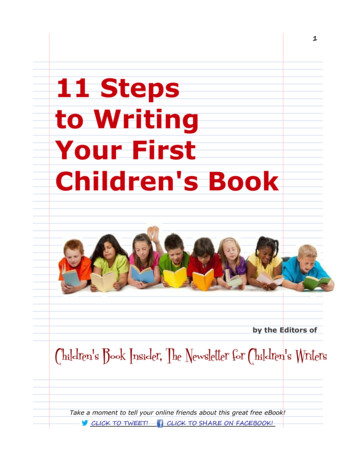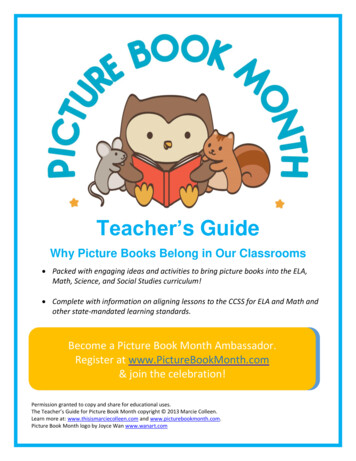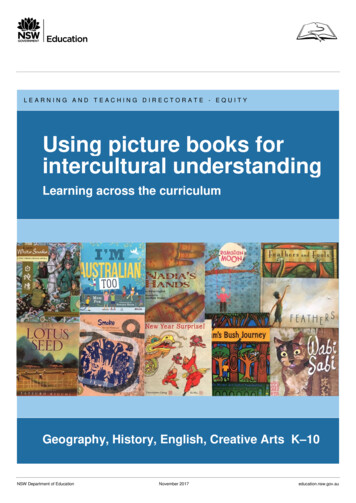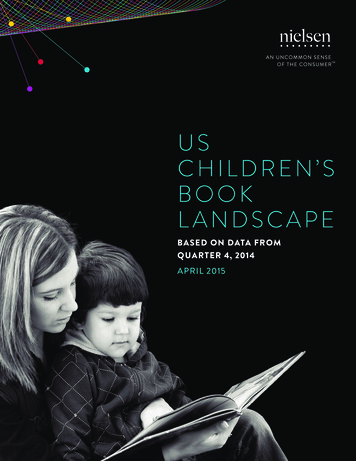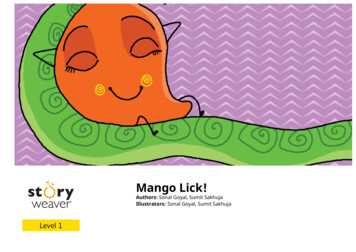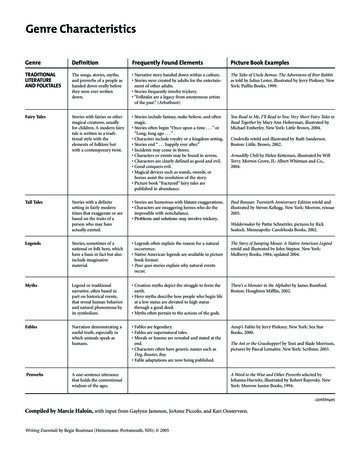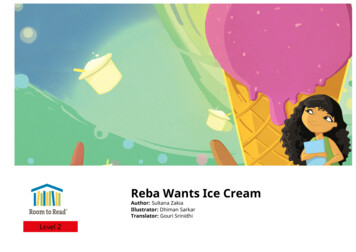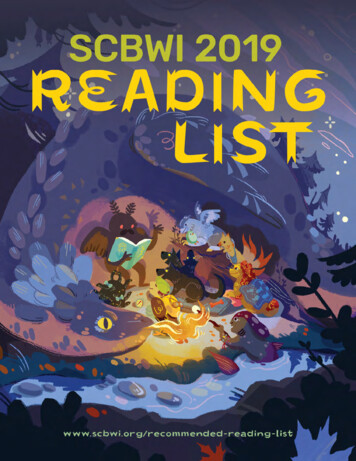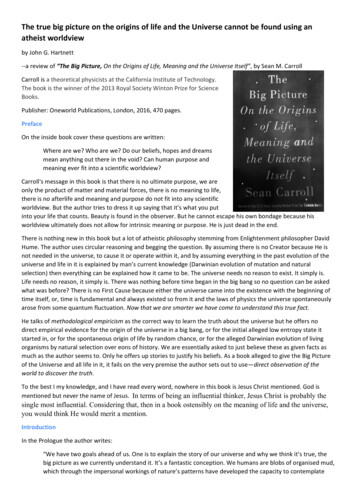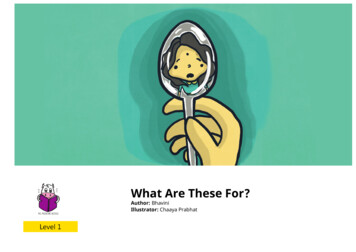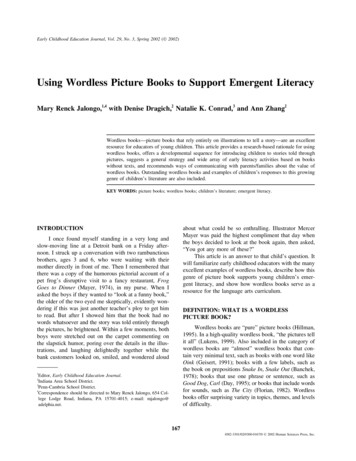
Transcription
Early Childhood Education Journal, Vol. 29, No. 3, Spring 2002 ( 2002)Using Wordless Picture Books to Support Emergent LiteracyMary Renck Jalongo,1,4 with Denise Dragich,2 Natalie K. Conrad,3 and Ann Zhang2Wordless books—picture books that rely entirely on illustrations to tell a story—are an excellentresource for educators of young children. This article provides a research-based rationale for usingwordless books, offers a developmental sequence for introducing children to stories told throughpictures, suggests a general strategy and wide array of early literacy activities based on bookswithout texts, and recommends ways of communicating with parents/families about the value ofwordless books. Outstanding wordless books and examples of children’s responses to this growinggenre of children’s literature are also included.KEY WORDS: picture books; wordless books; children’s literature; emergent literacy.about what could be so enthralling. Illustrator MercerMayer was paid the highest compliment that day whenthe boys decided to look at the book again, then asked,“You got any more of these?”This article is an answer to that child’s question. Itwill familiarize early childhood educators with the manyexcellent examples of wordless books, describe how thisgenre of picture book supports young children’s emergent literacy, and show how wordless books serve as aresource for the language arts curriculum.INTRODUCTIONI once found myself standing in a very long andslow-moving line at a Detroit bank on a Friday afternoon. I struck up a conversation with two rambunctiousbrothers, ages 3 and 6, who were waiting with theirmother directly in front of me. Then I remembered thatthere was a copy of the humorous pictorial account of apet frog’s disruptive visit to a fancy restaurant, FrogGoes to Dinner (Mayer, 1974), in my purse. When Iasked the boys if they wanted to “look at a funny book,”the older of the two eyed me skeptically, evidently wondering if this was just another teacher’s ploy to get himto read. But after I showed him that the book had nowords whatsoever and the story was told entirely throughthe pictures, he brightened. Within a few moments, bothboys were stretched out on the carpet commenting onthe slapstick humor, poring over the details in the illustrations, and laughing delightedly together while thebank customers looked on, smiled, and wondered aloudDEFINITION: WHAT IS A WORDLESSPICTURE BOOK?Wordless books are “pure” picture books (Hillman,1995). In a high-quality wordless book, “the pictures tellit all” (Lukens, 1999). Also included in the category ofwordless books are “almost” wordless books that contain very minimal text, such as books with one word likeOink (Geisert, 1991); books with a few labels, such asthe book on prepositions Snake In, Snake Out (Banchek,1978); books that use one phrase or sentence, such asGood Dog, Carl (Day, 1995); or books that include wordsfor sounds, such as The City (Florian, 1982). Wordlessbooks offer surprising variety in topics, themes, and levelsof difficulty.1Editor, Early Childhood Education Journal.Indiana Area School District.3Penn-Cambria School District.4Correspondence should be directed to Mary Renck Jalongo, 654 College Lodge Road, Indiana, PA 15701-4015; e-mail: mjalongo@adelphia.net.21671082-3301/02/0300-0167/0 2002 Human Sciences Press, Inc.
168RATIONALE: WHY USE WORDLESS BOOKSWITH YOUNG CHILDREN?Wordless picture books connect visual literacy(learning to interpret images), cultural literacy (learningthe characteristics and expectations of social groups) andliteracy with print (learning to read and write language).In making these linkages, wordless books support theliteracy skills highlighted below.Wordless Books Develop Book Handling BehaviorsBefore children can explore books for themselves,they need to learn how a book “works.” Such skills asidentifying the front and back of the book, top and bottom of the book, turning the pages one at a time, movingfrom right to left, as well as appreciating and respectingbooks pose challenges to toddlers (Rothlein & Meinbach, 1991). Wordless books are particularly useful inteaching children how a book works because most children recognize, interpret, and express themselves throughpictures long before they master print.Wordless Books Are Well Suited toContemporary Children’s StrengthsChildren live in a society dominated by visual images that they see on television, on computer screens,on billboards, and so forth. Because these books relatea story entirely through the illustrations, they encouragechildren to apply visual literacy skills and not only drawinferences from what is pictured but also respond to thequality of the pictures and note details that adults sometimes miss (Avery, 1996).Wordless Books Adapt to Special NeedsThrough wordless books, emergent readers, children with limited English proficiency, and older childrenwith various types of reading difficulties can draw ontheir interpretive skills. Likewise, children with hearingimpairments are able to comprehend the story, evenwithout hearing an accompanying spoken narrative. Unlike books with words that not-yet-readers cannot accessindependently, wordless books can be appreciated, shared,and enjoyed by children at many different stages ofemergent reading and levels of familiarity with the English language.Wordless Books Inspire Storytelling inMany Different FormsWordless picture books support learners who arenot yet deciphering print and build their confidence asJalongo, Dragich, Conrad, and Zhangreaders and writers. As they invent narratives, childrendevelop their sense of story, demonstrate an understanding of sequence, practice oral or written storytellingskills, and expand their cognitive abilities (Nelson, AksuKoc, & Johnson, 2001).Wordless Books Support Curricular IntegrationThe many different topics and subject areas represented by wordless books serve to integrate subject matter. A group of kindergartners who were familiar withAliki’s (1995) pictorial account of a tabby cat’s life wereinspired to create illustrated observational journals fortheir own pets and the class’ guinea pig during scienceclass. Then, as their knowledge of written language grewthroughout the school year, they added words to the pictures in their journals. The same students used wordlessbooks to represent math story problems in a concreteway.DEVELOPMENTAL APPROPRIATENESS:HOW ARE WORDLESS BOOKS MATCHEDTO THE CHILD’S LEVEL?Most wordless books are designed for 2- to 8-yearolds, making them ideally suited for the early childhoodyears. Yet wordless books differ considerably in termsof complexity and detail. Fig. 1 is an overview of thedevelopmental sequence for wordless books.SelectConcept books with clear, bright, simple picturesof familiar objects are the focus as in Tana Hoban’s(1969, 1976, 1989) or Helen Oxenbury’s (1991a, 1991b,1991c, 1982). Wordless books are suitable for the youngest readers because these books can be labeled in the“point and say” fashion used by toddlers. Wordlessbooks that depict a familiar routine such as going to bed(Omerod, 1982) and getting up in the morning (Omerod,1981) are well suited for young preschoolers. But whenthe pictures tell a story with a more elaborate plot suchas the Cherokee tale The Animals’ Ball Game (Arneach,1992) or contain intricate detail like the books The Angeland the Soldier Boy (Collington, 1987), they are generally better choices for kindergarten or the primarygrades. Just because a book is textless does not make itsuitable for young children. Actually, “a reader has toknow quite a lot about language to articulate the storythe pictures represent” (Hillman, 1995, p. 98). Take, forexample, the Brinton Turkle book, Deep in the Forest(1976). To fully appreciate the role reversal humor of
Wordless Picture Books and Emergent Literacy169CollectLevelsbook handlinglabelingpicturesinterpretingpictures and actionsinventing narrativestarting at the front and moving toward thebackholding the book right-side upturning the pages one at a timelooking at pictures from left to rightappreciating and responding to theillustrations(Rothlein & Meinbach, 1991)child responding to questions (e.g.,“Where’s the dog?”)child asking questions (e.g., “What’sthat?”)child pointing to items and makingappropriate gestures or soundschild labeling items with the correct wordadult interpreting pictures for the child andcomments on plotchild emulates interpretations of picturesand plotchild uses oral language to create a story toaccompany the illustrationschild invents a written text to accompanyillustrationschild invents original wordless picturebooksFig. 1. Matching Wordless Books to Children’s Developmental LevelGoldilock’s home being wrecked by the bears, a childmust first know the story of the three bears.When choosing wordless picture books, try to putyourself in the role of the child and think about all ofthe background knowledge that would be necessary inorder to interpret the theme. Most of Emily McCully’s(1987a, 1987b, 1988a, 1988b) wordless books containthemes that preschoolers can identify with—getting loston a family outing, reveling in the snow, going to school,and adjusting to a new baby. Because most young children would bring these experiences to these books, theycan “get” the story.Format, the book’s shape and size, is another consideration. Small format books such as The Yellow Umbrella (Drescher, 1987) are better for individual lapreading, while the larger format books lend themselvesto group sharing. A simple way to convert a tiny wordless picture book into a format that can be shared witha group is to make an enlargement of the story or toconvert each page of the book into a transparency forthe overhead projector.When evaluating the pictures in wordless picturebooks, “think of what you’d like to hang on the wall ofyour mind” (Hearne, 1983, p. 577) and avoid trite, cliché-ridden illustrations that do little to stretch the child’sthinking (Lukens, 1999).Consider gathering a collection of wordless bookswith the help of your librarian or published guides (seeLima & Lima, 2001; Richey & Puckett, 1992; TutenPuckett & Richey, 1993). Most computer-assisted searchestreat wordless books as a separate category, so they areeasy to locate. Using resources such as Booklist or SchoolLibrary Journal, strive to remain current about the newwordless books that are being published. Also be awarethat several of the best wordless books are available asfilms, such as Raymond Briggs’ delightful winter fantasy, The Snowman (1978).Use wordless books to build a special bond withparents and families who have limited proficiency withEnglish. They can understand, discuss, and enjoy thesebooks by relying on the illustrations. Family memberswho speak another language can write and record a textfor the wordless book that can be shared with other children who speak their language. Fig. 2 is an example ofChinese text to accompany the wordless book, JungleWalk (Tafuri, 1988) prepared by Ann Zhang. Wordlessbooks do require an introduction. Otherwise familiesmay not understand the point of a book without words.Fig. 3 contains a letter to parents from first-gradeteacher Denise Dragich that explains the use of wordlesspicture books.SupportUse wordless books as a language experience.After a child has viewed the entire book, invite her orhim to produce an accompanying story. You may wantto set up a recording area for this purpose so that children can do this more independently, and then ask aclassroom volunteer to print or type the stories. Do notforget to include an audible signal at the end of eachpage, such as a bell, just like the professionally recordedstories. Familiarity with the words and the page-turningsignal supports children in memorizing the texts theyhave invented and in tracking the print, both importantemergent literacy skills. If you make the children’s varied interpretations of wordless books part of your classroom lending library, you soon will find that these booksbecome favorites. At the end of the school year, childrencan take them home as keepsakes.IMPLEMENTATION:WHY AREN’T WORDLESS BOOKSUSED MORE EXTENSIVELY?Survey research with classroom teachers identifiedbarriers to the effective use of wordless picture books in
170preschool and elementary classrooms (Raines & Isbell,1988, 1994). One obstacle was the fact that many teachers were relatively unfamiliar with the genre and didnot know how to select quality wordless books. Anotherimpediment was that few teachers had considered themany ways in which wordless picture books could support young children’s growth in literacy. Additionally,many teachers reported that their public and school libraries were not well stocked with wordless books.Many teachers and librarians balk at the idea of a bookthat has few words or none at all. If the purpose of booksis to read them, then what good is a book withoutwords? they wonder. Yet, as an undergraduate earlychildhood major remarked, “When you really startthinking about it, there’s a lot you can do with a word-Jalongo, Dragich, Conrad, and Zhangless book.” Fig. 4 provides a list of activities to try withwordless books.EVALUATION: INFORMAL LANGUAGEASSESSMENT WITH WORDLESSPICTURE BOOKSBegin by asking students to make predictions aboutthe story based on the title alone. For young children,books with simple, straightforward titles like Pancakesfor Breakfast (de Paola, 1978) are a good choice. Forchildren in the primary grades, try books with intriguingtitles such as Double Dutch and the Voodoo Shoes: AModern African-American Urban Tale (Rosales, 1991).Working with book titles is also a good way to check
Wordless Picture Books and Emergent Literacyon children’s comprehension of the main idea after theyhave interpreted the pictures in the book. Invite the children to discuss the suitability of the title selected by theauthor and suggest other possible titles (Raines & Isbell,1988).When children are invited to compose a written textfor the book, they make the wordless picture book“word-full” (Tompkins, 1987). This can be done individually, with a partner, or in a group. One suggestionfor working with an individual child is to position thechild’s written words on each page, using self-adhesivenotes. Fig. 5 shows a story written by a second graderin response to Sir Andrew (Winter, 1976), the slapstickstory of a vain donkey who is accident-prone. If workingwith a group, text can be written with a marker on over-171head transparencies of each page. Step-by-step guidelines for composing individual and group stories withwordless books include:1. Introduce wordless books as a special category of literature.2. Model the process of first going through all of the pictures ina book, and then demonstrate to the children how you inventa narrative and/or dialogue, page by page.3. Choose a different book and look through all of the picturestogether.4. Go back to the beginning of the book and invite the child orchildren to tell a story. Write down the comments while thechild or children watch.5. Read and view the entire story together. Ask if the child orchildren want to make any changes.6. Provide an assortment of wordless books and invite each childto choose one and develop an accompanying story in small
172Jalongo, Dragich, Conrad, and Zhang
Wordless Picture Books and Emergent Literacy173
174Jalongo, Dragich, Conrad, and ZhangFig. 2. Text Written in Chinese and English for Junglewalk. Ann Zhang wrote the text for this book in both languages while in sixth grade.Illustration from Nancy Tafuri (1988) Junglewalk. New York: Greenwillow. Reprinted with permission.Dear Families:We are starting the year with books that tell a story entirely through pictures. These books, called wordless books, are used tosupport your child’s reading in several important ways. Wordless books will enable your child to: interpret meaning from pictures and notice detailspractice beginning reading skillsunderstand sequence and story plots bettergain confidence in sharing a book with a groupuse storytelling as the basis for reading and writingLater this week you will receive an audio tape of the story your child invented to go along with the pictures in the book.Please listen to it together and write a sentence or two on the comment card enclosed in the plastic bag.Next, your child will produce a written text to go along with the book. If you can spare some time to help print or type these. You will receive a copy of the wordless book with the child’s written version of the storytexts, please give me a call atin a couple of weeks. Enjoy sharing it together. Even though it may not seem like “real” reading, memorizing a story and payingattention to the print is how reading begins.Throughout the year, your child will have the opportunity to borrow book/tape packets created by the other children from ourclassroom library.Your support of this project is appreciated. The children are very excited about sharing their stories and showing you whatthey have learned!Sincerely,Ms. DragichFig. 3. Letter to Parents About Wordless Books
Wordless Picture Books and Emergent Literacygroups, with a partner, or individually. Stories may be told,recorded on audio or video, dictated to an adult, or written bythe child.7. Make copies of the books to circulate in the classroom library.When the story is complete, this information canbe used to conduct an informal assessment of the child’snarrative abilities, examining such variables as storylength, story setting, sequence/plot, characterization, dialogue, and vocabulary (van Kraayenoord & Paris,1996). Generally speaking, young children’s stories thatare told with a wordless book as a prop are more sophisticated in terms of length, setting, plot, characters,theme, style, complexity, and vocabulary than stories175that are generated without a wordless book (Norton,1996).CONCLUSIONReturning to the child’s question that introducedthis article, “Do you got any more of these?” the answeris a resounding “Yes!” There are many different, practical, and worthwhile uses for wordless books in earlychildhood settings; uses that enhance children’s motivation to learn, support growth in literacy, provide performance assessment data, and foster communication withfamilies. Record the story inspired by the wordless book. Dictate a story to a teacher, tutor, volunteer, or use computer software that converts children’s speech to print. If an audio or videotape is made, make it part of a lending library and send it home in a plasticcase. Change the format of a wordless book. “Translating” a story from one format to another provides good practice in comprehension. Children could convert a wordless book into a big book or pocket-sized book with a written text. They might try creating abook with moving parts, such as a lift-the-flap book. Draw a prequel or a sequel. Wordless books help children to develop a sense of story and narrative abilities, particularly if theyimagine the past and future of the story. Focus on the plot. Children can chart or map the plot. Use a paperback copy or duplicated copy of the pictures, cut apart, laminate and arrange in sequence on the floor or chalkboard ledge. One book that is especially well suited to this is Jeannie Baker’s(1991) Window, a story that shows what happens as a country environment becomes increasingly urbanized. Dramatize the story. Children can role play a particular scene or the entire story, invent dialogue between and among characters,or use simple puppets to reenact the story. Try dramatizing Changes, Changes (Hutchins, 1971) using blocks and toys. Create a group mural. Draw a mural with cartoon bubble dialogue, a storyboard that is presented in frames, like a cartoon strip,or use cardboard tubes to create a story scroll. Write a text in a different language. Wordless books are well suited to support linguistically and culturally diverse students andfamilies. Invite parents and their children to invent a story for the wordless book in their first language, and then share the storyin both languages with the children (see Figure 2). Revisit the invented text for a wordless book. After children have written a text to accompany a wordless book, they can returnto it and make a different story or a story from another character’s point of view. Use photographs of classroom or center activities. A series of photographs can become the basis for a wordless book. After thechildren have arranged the photos to document an event, invite them to write captions for each one. Invent original wordless books. Wordless books support creative expression and can be used to explore different art media andtechnology. Try having one group of children create the illustrations for a wordless book, then have another group dictate orwrite a text for the book. Make a book with a text into a wordless book. Convert a new story book or a book that is unfamiliar to the children into a wordless book using strips of construction paper to cover the words. Ask the children to imagine what the author wrote about eachpicture before actually reading it. Investigate an artist’s style. Gather two or more wordless books by the same author, and then gather the books of different authors. Ask the children to cluster books together by looking at illustrations alone and ask them to explain how they decided.Point out that these things are the artist’s style. Work with older students. Consider a project in which students, such as 6th graders or high school art students, create a wordlessbig book and present it to young children. Smaller sized wordless books can be produced, laminated, and donated to the library.Older children can also volunteer to type or print the original texts that children create for wordless books (see Swan, 1992). Contrast wordless books in different media. Use the film version Mercer Mayer’s (1973) Frog Goes to Dinner. The film is liveaction while the book consists of cartoon drawings. Invite children to compare/contrast the two using a Venn diagram. Invent a wordless book. Using clip art on the computer, create a wordless language experience story (e.g., Our Trip to the Zoo),then compose a text and make into a big book or story chart.Fig. 4. Learning Activities Based on Wordless Books
176Jalongo, Dragich, Conrad, and ZhangHe is singing in the shower. He dries off. He puts on cream. He very happy and now he’s mad. He dries his hoof and his catgo after his fish. He gets on the outfit and the cat eats one of the fish. He got on his hat and went for a walk and out thedoor. He went . . . uh oh! He go to the hospital and went to sleep and the next day he went home. He lost his hat. He almostgot car squished. Oh yes! He had his hat! And he has a broken leg and the pig got mad. Oh, No! Oh, boy! Watch out!Fig. 5. A Second Grader’s Text for Sir Andrew. Illustration from Paula Winter (1980). Sir Andrew. New York: Crown.REFERENCESAvery, C. (1996). The wordless picture book: A view from two. Reading Improvement, 33, 167–168.Hearne, B. (1983). Choosing books for children. New York: DelacourteHillman, J. (1995). Discovering children’s literature. EnglewoodCliffs, NJ: Prentice Hall.Lima, C. W., & Lima, J. A. (2001). A to zoo: Subject access to children’s picture books. Westport, CT: Bowker/Greenwood.Lukens, R. J. (1999). A critical handbook of children’s literature (6thed.). New York: Addison Wesley/Longman.Nelson, K. E., Aksu-Koc, A., & Johnson, C. E. (Eds.). (2001). Children’s language: Developing narrative and discourse competence. Mahwah, NJ: Lawrence Erlbaum.Norton, D.E. (1996). The impact of literature-based reading. UpperSaddle River, NJ: Prentice Hall.Raines, S. C., & Isbell, R. (1988). Tuck talking about wordless booksin your classroom. Young Children, 43(6), 24–25.Raines, S. C., & Isbell, R. (1994). Stories: Children’s literature inearly education. Albany, NY: Delmar.Richey, V. H., & Puckett, K. E. (1992). Wordless/almost wordlesspicture books: A guide. Englewood, CO: Libraries Unlimited.Rothlein, L., & Meinbach, A. M. (1991). The literature connection:
Wordless Picture Books and Emergent LiteracyUsing children’s books in the classroom. Glenview, IL: Scott,Foresman/GoodYear.Swan, A. M. (1992). Wordless picture book buddies. The ReadingTeacher, 45(8), 655.Tompkins, G. E. (1987). An untapped writing resource: Wordless picture books. In G. E. Tompkins & C. Goss (Eds.), Write angles:Strategies for teaching composition (pp. 75–82). (ERIC Document Reproduction Service No. ED 298 529)Tuten-Puckett, K. E., & Richey, V. H. (1993). Using wordless picturebooks: Authors and activities. Englewood, CO: Teacher IdeasPress.van Kraayenoord, C. E., & Paris, S. G. (1996). Story construction from177a picture book: An assessment activity for young learners. EarlyChildhood Research Quarterly, 11(1), 51–61.Children’s BooksComplete bibliographic information for the books cited and an extensive list of additional wordless books are on the Companion Web Sitefor Jalongo, M. R. (2002). Early childhood language arts (3rd ed.).Boston: Allyn & Bacon. at http://cw.abacon.com/bookbind/pubbooks/jalongo ab/chapter1/deluxe.html
Reproduced with permission of the copyright owner. Further reproduction prohibited without permission.
Wordless Books Inspire Storytelling in know quite a lot about language to articulate the story Many Different Forms the pictures represent” (Hillman, 1995, p. 98). Take, for Wordless picture books support learners who
